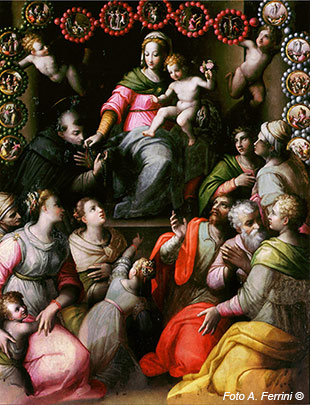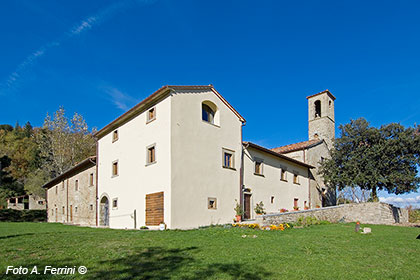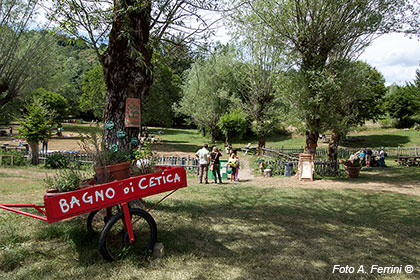 With the name Cetica we identify a mountain village in the Municipality of Castel San Niccolò. However, identifying Cetica with a wide territory on the slopes of the Pratomagno would be more appropriate.
With the name Cetica we identify a mountain village in the Municipality of Castel San Niccolò. However, identifying Cetica with a wide territory on the slopes of the Pratomagno would be more appropriate.
In this area we find many built up ares of various dimensions, three very interesting ancient churches and a Medieval bridge on the Solano Torrent. All this is interspersed with agricultural lands that have made Cetica long famous for its products, such as: chestnuts, apples and potatoes. In particular the red potato, which has been rediscovered over the past few years and has become the crown-jewel of this area.
From the historic point of view, during the Middle Ages, Cetica was under the domain of the Guidi. Here there was also a castle, called Castello di Sant'Angelo, which belonged to this noble family and was placed where today we find the Church di Santa Maria, which is in a dominant position over the Solano valley. The castle was destroyed by the Florentines in 1290, the year after the Battle of Campaldino. In 1349, the inhabitants of the whole valley rebelled against the Guidi, who at this point were severely weakened, and asked to the Republic of Florence to be annexed to its county. Such request was accepted and this vast territory took the name of "Florentine Mount".
During the Middle Ages and later on, this area was also influenced by Vallombrosa. As a matter of fact, the churches of San Pancrazio and San Michele have a Vallombrosano monastic order origin. During the previous centuries, the Vallombrosano order had been expanding its spiritual and political domain all over the Pratomagno. Such domain will reach its peak in 1425 when Vallombrosa, which is located on the northern slopes of the massif, obtained Badia Santa Trinita, which is on the soutern slopes of the mount. We can get to Cetica through three roads. Two of these start very close to each other and their entrance is on the road that from Strada in Casentino takes to Montemignaio. The itinerary described in this web section starts from the first one of these (which we  enter taking the left near a place called Pagliericcio) and goes back through the second one (which leads to entering on the same road that takes to Montemignaio, but approximately one kilometer before). The third road that takes to Cetica comes down from the Pratomagno. After less than one kilometer from its entrance, located on the white roadway that from the area of the Cross leads to Mount Secchieta, we find Bagno di Cetica. It is a thermal area that, according to legends and traditions, was supposed to be already frequented by the ancient Romans; while, according to historical documents, we have proof of these waters since 1205. In this area there is a green and very fresh park with spring water coming out in several spots. Here is located a large building containing a restaurant, bedrooms and, on the back, three rooms on the ground floor equipped with tubs where it is possible to immerse our legs in the icy water. In the middle of the grassland there is a chapel. A small painting kept inside it recalls of a legendary meeting that might have taken place in this location between San Giovanni Gualberto, founder of Vallombrosa, San Romualdo, founder of Camaldoli, and the soul of San Romolo, patron of Fiesole. Together they prayed and blessed the waters of this place, which acquired the beneficial properties that made them famous. From this thermal station, we go down to Cetica in about fifteen minutes by car.
enter taking the left near a place called Pagliericcio) and goes back through the second one (which leads to entering on the same road that takes to Montemignaio, but approximately one kilometer before). The third road that takes to Cetica comes down from the Pratomagno. After less than one kilometer from its entrance, located on the white roadway that from the area of the Cross leads to Mount Secchieta, we find Bagno di Cetica. It is a thermal area that, according to legends and traditions, was supposed to be already frequented by the ancient Romans; while, according to historical documents, we have proof of these waters since 1205. In this area there is a green and very fresh park with spring water coming out in several spots. Here is located a large building containing a restaurant, bedrooms and, on the back, three rooms on the ground floor equipped with tubs where it is possible to immerse our legs in the icy water. In the middle of the grassland there is a chapel. A small painting kept inside it recalls of a legendary meeting that might have taken place in this location between San Giovanni Gualberto, founder of Vallombrosa, San Romualdo, founder of Camaldoli, and the soul of San Romolo, patron of Fiesole. Together they prayed and blessed the waters of this place, which acquired the beneficial properties that made them famous. From this thermal station, we go down to Cetica in about fifteen minutes by car.
 From the Middle Age to the motorization times, with the consequent building of new roads, Cetica has witnessed a remarkable logistical importance. Over this territory passed several itineraries coming from the valley floor of Casentino, which headed for different points of the Pratomagno ridge depending on which areas of the Valdarno we wanted to get to. We had to use the Crossing of the Vetrice if we wanted to go down to Castelfranco where the abbey of Soffena was situated; the Crossing of Gastra to get to Pian di Sco' and its Parish Church of Santa Maria; the Crossing of Reggello to arrive to the town carrying its same name and to the very close Parish Church of San Pietro a Cascia.
From the Middle Age to the motorization times, with the consequent building of new roads, Cetica has witnessed a remarkable logistical importance. Over this territory passed several itineraries coming from the valley floor of Casentino, which headed for different points of the Pratomagno ridge depending on which areas of the Valdarno we wanted to get to. We had to use the Crossing of the Vetrice if we wanted to go down to Castelfranco where the abbey of Soffena was situated; the Crossing of Gastra to get to Pian di Sco' and its Parish Church of Santa Maria; the Crossing of Reggello to arrive to the town carrying its same name and to the very close Parish Church of San Pietro a Cascia.
As above mentioned, this web section will accompany us in a visit to Cetica starting from Pagliericcio and arriving to Barbiano, which is extremely close to the starting point. After showing the geographic position of this place, it will show us an ancient water mill where it is possible to buy wheat, corn and chestnut flour just come out from the heavy grindstones; the Medieval Sant'Angelo Bridge on the Solano Torrent; the Parish Church of San Michele Arcangelo with its precious works of art; the Church of Santa Maria with its bell tower leaning and separated from the building for a few meters; the Church of San Pancrazio and its housing complex, which nowadays has been completly restored and designated for welcoming people and for holding spiritual courses suggested by Rita and Vittoria; an artisan delicatessen in Barbiano, where it is possible to purchase excellent traditional products.